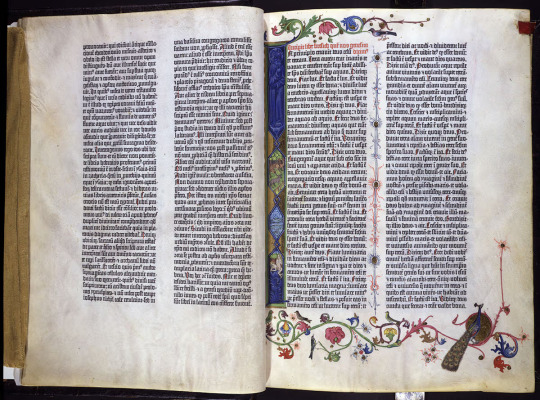“Those who cannot remember the past are condemned to repeat it.” – George Santayana
Don't wanna be here? Send us removal request.
Text

Portolan atlas - Francesco Ghisolfi
In the 16th century, Europeans did not perceive much about the world. This map, drawn by Francesco Ghisolfi depicts how much they knew. As you can see, Europe is the most accurate continent on this map. This shows how distance decay affected people at the time. Distance decay means that the farther the place, the less one knows about it.
#history#art#art history#16th century#1500s#the huntington#huntington library#distance#maps#map#geography#cartography#cartographer#continents#europe#africa#asia#australia#south america#antarctica#north america#travel#explore#explorers#human geography
1 note
·
View note
Text

The Gutenberg Bibles were printed by a man named Johann Gutenberg who lived from 1397 to 1468. It is 1 out of 48 copies left in the world that was printed by one of the first printing presses in Europe. At first there were around 200 copies, but now only 48 remain. The Bible is 16 inches tall, 12 inches wide, and weights around 60 pounds. Since the book is so big, we can assume that it was not used by one person, but for institutional use, such as in churches.
#history#14th century#15th century#bible#the bible#christianity#religion#books#art#printing#printer#printing press#europe#revolutionary#medieval
2 notes
·
View notes
Text

Harriet Goodhue Hosmer was one of the first professional female sculptors of the 1800s. She was born in 1830 and died in 1908 after creating many stunning sculptures. Harriet even had a bluff(a steep cliff, bank, or promontory) named after her in Iowa and during WWII a ship was named after her, the SS Harriet Hosmer. What did she do to be this important in history? Well women in the 19th century did not have jobs and were held back from fulfilling their true potentials. Harriet was forbidden from attending art classes, but instead of giving up because of her gender, she took anatomy classes to learn how to sculpt humans. She later moved to Rome, Italy to study art. There she received many commissions and became one of the most famous female sculptors of her time. Harriet was also openly a Lesbian and was involved with a woman named Louisa, also known as Lady Ashburton. Overall, Harriet showed how women could be just as artistic as men and be their equals. She became one of the most successful sculptors of her era, even with societal norms and pressure.
"I honor every woman who has strength enough to step outside the beaten path when she feels that her walk lies in another" - Harriet Goodhue Hosmer
#art history#herstory#history#sculptures#rome#women#women empowerment#feminism#queer#queer artist#equality#equal rights#art#artist#woman sculptor#sculptor#1800s#1800s art#19th century
14 notes
·
View notes
Text

This marble sculpture was created by Harriet Goodhue Hosmer in 1859. It depicts Zenobia, the third-century queen of Palmyra (in present day Syria). She was born in 240 AD and died after 274 AD. She is shown wearing a beautiful dress and chains. During her time, Zenobia lead a rebellion against the Roman Empire, which resulted in her being captured. She was eventually freed when Emperor Aurelian saw Zenobia's beauty and dignity while shackled.
📸The Huntington Library, Art Museum, and Botanical Gardens, San Marino, California.
#art history#history#herstory#sculpture#marble statue#marble sculpture#museum#museums#queen#queens#ruler#rebellion#huntington library#the huntington#empires#roman empire#palmyra#california#socal#southern california
24 notes
·
View notes